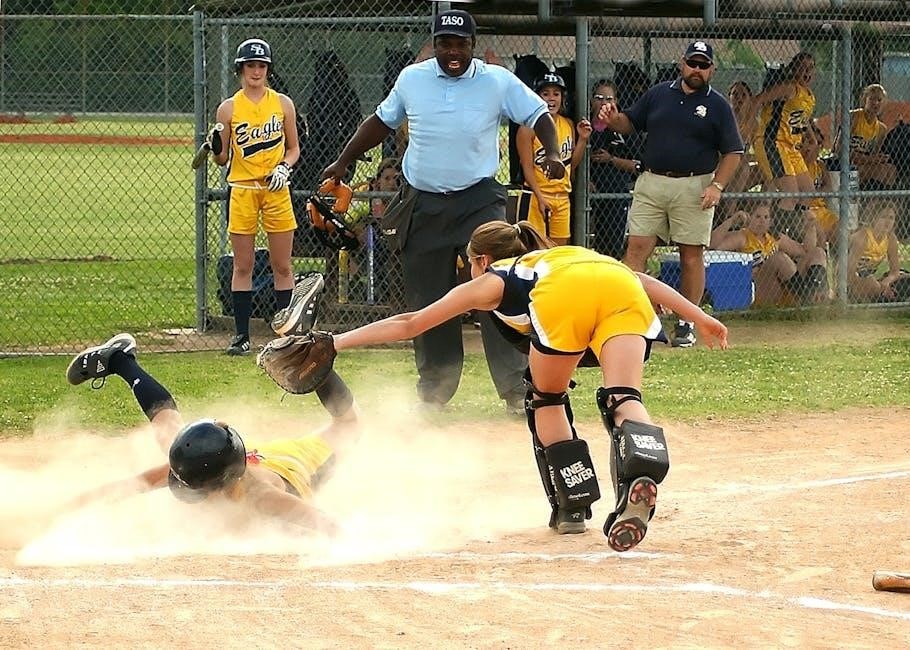
how to manually retract a slide out
How to Manually Retract a Slide Out: A Comprehensive Guide
Manually retracting an RV slide ensures safety and control‚ especially during emergencies. This guide provides step-by-step instructions and essential tips for smooth operation and maintenance. Stay prepared for any situation with ease.
Can All RV Slides Be Manually Retracted?
Not all RV slides can be manually retracted‚ as it depends on the type of slide mechanism installed. Hydraulic slides require opening manifold valves and physically pushing them in‚ which is labor-intensive. Schwintek slides may need motor removal and manual pushing on the failed side. Rack and pinion slides often have a manual override crank. Always consult the manufacturer’s instructions for specific guidance. Some systems may not support manual operation‚ so prior knowledge of your slide type is crucial to avoid damage. If unsure‚ contacting a professional is recommended to ensure safety and proper function.
Basic Troubleshooting Steps for an RV Slide Out That Won’t Retract
If your RV slide out won’t retract‚ start by checking the basics. Ensure the RV is level‚ as an uneven surface can stress the mechanism. Verify battery voltage and connections‚ and check for blown fuses or tripped circuit breakers. Low power or a dead battery may prevent motor operation. Next‚ inspect the slide-out for obstructions or debris that might block movement. Consult the owner’s manual for specific troubleshooting steps tailored to your system. If issues persist‚ consider seeking professional assistance to avoid further complications. Early detection of problems can prevent costly repairs and ensure your RV remains functional during trips.

Manual Retraction Methods
Identify your slide type (rack and pinion‚ hydraulic‚ or Schwintek) and use the appropriate manual override method. This may involve cranking‚ pumping‚ or pushing the slide in safely.
Rack and Pinion Slides
Rack and pinion slides are common in RVs. To manually retract‚ locate the extension rod attached to the motor. Disconnect the battery for safety. Attach the manual override crank to the rod and turn it clockwise to retract. If the rod has a hex nut‚ place a wrench on it and rotate clockwise. Ensure the slide moves smoothly and check for obstructions. Apply lubrication to moving parts if needed. After retracting‚ secure the slide with bolts or locking mechanisms to prevent movement. Regular maintenance‚ like greasing the rack‚ prevents future issues. Always follow manufacturer guidelines for specific models to avoid damage.
Hydraulic Slides
Hydraulic slides rely on a motor-driven system for operation. To manually retract‚ locate the motor and hand pump. Use the pump to build pressure and slowly push the slide in. Open the manifold valves to release fluid‚ allowing manual retraction. This process is labor-intensive and requires careful handling. Ensure the system is depressurized before starting to avoid damage or injury. Use a wrench or crimper to open valves and direct the slide inward. Once retracted‚ secure the slide with bolts or locks. Regular lubrication of hydraulic components prevents corrosion and ensures smooth operation. Always follow manufacturer guidelines for specific hydraulic systems to maintain functionality and safety. Proper maintenance can prevent future issues and extend the lifespan of the slide-out mechanism.

In-Wall (Schwintek) Slides
Manually retracting Schwintek slides involves removing the failed motor and operating the mechanism manually. Locate the motor on the side of the slide and disconnect it. While running the other motor‚ push the failed side inward. Use a wrench or crank to manually override the system. Ensure the slide is aligned properly to avoid damage. Secure the slide once retracted to prevent movement. Regular maintenance‚ such as lubricating gears‚ can prevent future issues. Follow manufacturer instructions for specific Schwintek systems‚ as improper handling may cause mechanical failure. This method is effective for emergencies but should be followed by professional servicing to restore automatic operation. Always prioritize safety and stability when handling these mechanisms.

Tools and Preparation
Gather essential tools like a manual crank‚ wrench‚ and lubricant. Ensure the RV is stable and clear of obstacles. Prepare for specific slide types‚ following manufacturer guidelines for safe operation.
Essential Tools for Manual Retraction
To manually retract your RV slide‚ gather essential tools like a manual override crank‚ wrench‚ and screwdriver. For rack and pinion slides‚ a hex nut wrench or extension rod may be needed. Hydraulic slides require a hand pump and valve keys‚ while Schwintek slides often need an Allen wrench or T-handle. A multi-tool or pliers can assist with stubborn parts. Always have lubricants on hand to prevent friction damage. Ensure you have a flashlight for visibility and gloves for grip. Additionally‚ keep a battery tester to check power sources and blocks for stabilizing the slide during retraction. These tools will help you safely and effectively manually retract your slide-out in emergencies. Proper preparation ensures a smoother process and minimizes potential damage to your RV. Always consult your owner’s manual for specific tool recommendations tailored to your slide type.
Before manually retracting your RV slide‚ ensure safety by turning off the motor power and stabilizing the RV with jack stands or blocks. Check that the RV is level to prevent uneven stress. Gather essential tools like wrenches‚ hex keys‚ or valve keys‚ depending on your slide type. Wear protective gear such as gloves and safety glasses. Engage any available slide locks or brakes to secure the slide during retraction. Ensure proper lighting‚ especially in tight spaces. If the slide is heavy or stubborn‚ consider enlisting help to avoid accidents. Avoid forcing the slide‚ as this could cause damage. Finally‚ refer to your owner’s manual for specific instructions or precautions‚ and know when to seek professional assistance if the situation becomes too challenging.
Step-by-Step Manual Retraction Process
Safety Precautions Before Starting
Ensure the RV is stable and level‚ using jack stands or blocks to prevent movement. Disconnect power to the slide motor and wear protective gear. Secure the slide with locks or brakes. Avoid forcing the slide‚ as this can cause damage. If unsure‚ seek professional help. Always refer to the owner’s manual for specific instructions and precautions to ensure a safe and successful manual retraction process.
Locating the Motor and Access Points
Start by identifying the type of slide mechanism your RV uses—rack and pinion‚ hydraulic‚ or Schwintek. For electric slides‚ the motor is typically located on the opposite side of the slide. Look for access points such as holes in the J-rail or frame. Hydraulic systems often have a hand pump and manifold valves near the motor. For Schwintek slides‚ access the motor by removing interior panels. Always consult your RV’s manual for specific locations. Once located‚ ensure the area is clear of obstructions. If no access holes are present‚ you may need to remove underbelly panels. Use a flashlight to illuminate hidden components. Properly identifying these points is crucial for safe and effective manual retraction. Take your time to avoid damaging the mechanism or surrounding structures.
Using the Manual Override Crank
First‚ ensure your RV is level to prevent additional stress on the slide mechanism. Disconnect the battery or switch off the power supply to avoid motor activation during manual operation. Attach the manual override crank securely to the motor—most systems have a designated fitting for this purpose. Slowly turn the crank clockwise to begin retracting the slide. Apply steady‚ consistent pressure; initial resistance is normal‚ especially if the slide is stuck. Monitor the slide’s movement‚ ensuring it aligns properly with the RV wall. If it feels overly difficult‚ stop and check for obstructions or consider lubricating moving parts. Once fully retracted‚ secure the slide using the brake assembly to prevent movement. Always maintain control and be cautious of potential strain or unusual noises‚ which may indicate underlying issues requiring professional attention. After retraction‚ test the slide’s operation to ensure proper function.
Pushing the Slide Out In
Once the manual override is engaged‚ carefully position yourself to push the slide out inward. Ensure the slide is properly aligned with the RV wall to avoid damage. Check for any obstructions‚ such as furniture or debris‚ that could hinder smooth retraction. If the slide is heavy or stubborn‚ consider enlisting assistance to evenly distribute the force. Apply steady‚ consistent pressure while maintaining control to guide the slide back into its compartment. Avoid jerky movements‚ as they may cause misalignment or mechanical stress. As the slide moves inward‚ monitor its progress to ensure it glides smoothly and stops flush with the RV exterior. Once fully retracted‚ secure it using the manufacturer-recommended locking mechanisms to prevent unintended movement. Always prioritize safety and caution during this process to avoid injury or further complications. Proper technique ensures a successful manual retraction and protects your RV’s slide-out system from damage. Be patient and methodical to achieve the best results.
Post-Retraction Steps
After manual retraction‚ secure the slide with locks or latches. Inspect for damage‚ lubricate moving parts‚ and ensure proper alignment. Regular maintenance prevents future issues and ensures smooth operation.
Securing the Slide Out

After manually retracting the slide out‚ ensure it is properly secured to maintain stability and prevent movement. Use the locking mechanisms or latches provided by the manufacturer to hold the slide firmly in place.
Check the slide’s seals for any damage or debris‚ as this can compromise the watertight fit. Clean the seals and apply a rubber conditioner if necessary to prevent cracking over time.
If your RV has stabilizers‚ you can use them to support the slide out‚ but only if recommended by the manufacturer. This helps prevent sagging and ensures the slide remains level.
Finally‚ inspect the slide’s alignment with the RV’s wall to ensure proper fitment. Make any necessary adjustments to the slide’s positioning to avoid future operational issues.
By following these steps‚ you can ensure your slide out remains secure and functional for future use.
Maintenance and Future Prevention
Regular maintenance is crucial to prevent future issues with your RV slide out. Lubricate the gears‚ tracks‚ and moving parts to ensure smooth operation and reduce wear and tear.
Inspect the slide’s electrical connections and motor for damage or corrosion. Clean or replace components as needed to maintain proper function.
Check the slide’s alignment and adjust it if necessary to avoid uneven stress on the mechanism. Use a silicone-based lubricant on seals to prevent drying and cracking.
Consider installing slide-out supports to prevent sagging and ensure stability over time. Keep the area around the slide clean to avoid debris buildup.
Address any minor issues promptly to prevent them from becoming major repairs. Regularly test the slide’s operation to identify potential problems early.
By following a consistent maintenance routine‚ you can extend the life of your slide out and ensure reliable performance for years to come.